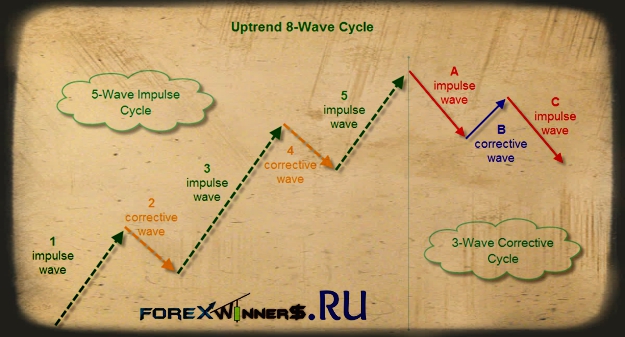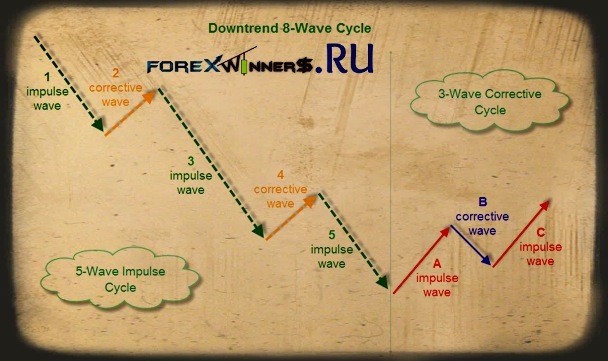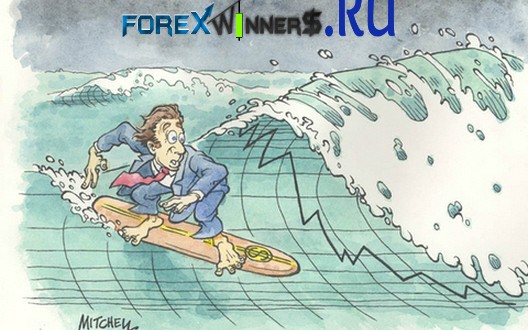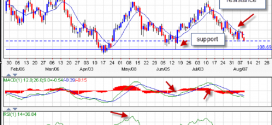Elliot Wave Theory and Principle
Although my system mainly focuses on Channels and Fibonacci retracements, I also pay attention to the Elliott Wave Theory, because it provides vital information about price movement.
The Elliott Wave Principle is a type of technical analysis that utilizes past cycles or repetitive patterns to identify predictable market behaviour. It was developed by Ralph Nelson Elliott, who published his theory of market behaviour in the book, “The Wave Principle” in 1938.
According to the theory, the market moves in repetitive cycles. These cycles represent the emotions of investors, caused by outside influences or the general psychology of the population. These emotions cause repetitive price swing patterns, called waves, and being familiar with these behaviours can help identify where the price will probably go next.
There are two types of waves, impulse and corrective waves. Impulse waves follow the main direction of the waves, while corrective waves go against the main direction.
In a trending market, a combination of these waves make up a complete cycle of 8 waves, which is composed of two major types of wave patterns. The first type is the 5-wave impulse pattern followed by a 3-wave corrective pattern.
In an uptrend, the 5-wave impulse pattern consists of 5 waves, with waves 1, 3 and 5 as impulse waves (going up), and waves 2 and 4 as corrective waves (going down). Once the impulse pattern has formed, it is normally corrected by a 3-wave cycle. Wave A and C are impulse waves (going down) and wave B is a corrective wave (going up).

In a downtrend, the 5-wave impulse pattern also has 5 waves, but the impulse waves 1, 3 and 5 are going down, and the corrective waves 2 and 4 are going up. The 3-wave corrective pattern also has 3 waves, with the impulse waves A and C going up, and the corrective wave B is going down.

The waves can be classified in different degrees. Here is the general standard order of degrees with their approximate duration:
Grand Supercycle Multi-century
Supercycle Multi-decade (about 40-70 years)
Cycle One year to several years
Primary A few months to a couple of years
Intermediate Weeks to months
Minor Weeks
Minute Days
Minuette Hours
Subminuette Minutes
The 5-wave cycle is also known as the 1-2-3-4-5 pattern, and once it has formed, it is normally corrected by a 3-wave cycle, also known as the ABC pattern.
Each wave of has its unique characteristics. Here is a summary of the different types of waves.
Wave 1 – impulse
This is the initial move towards the new trend direction. In an uptrend, the first wave is going up. A small number of people thought that the price was low so they bought the currency, and this caused the price to rise.
Wave 2 – correction
Seeing that the price has gone up considerably, traders who bought the currency at the beginning of wave 1 usually take their profits by this time. This causes the price to go down again and become very attractive to more investors. Wave 2 usually retraces at Fibonacci levels, and it never goes lower than the low of wave 1.
Wave 3 – impulse
By this time, more and more investors would have noticed the currency’s beginning trend, and so more people would dive in the market, making this wave normally longer and stronger than the other waves.
Wave 4 – correction
By wave 4, the price has gone considerably high in an uptrend and very low in a downtrend. Traders take their profits again. Although price makes a correction, it’s not strong enough to even reach the high of wave one. Wave 4 also retraces with respect to Fibonacci levels as well.
Wave 5 – impulse
The price may have retraced in wave 4 but is still overpriced or underpriced. However, most traders will still get in the market unreasonably. Wave 5 can also be the longest of the waves, but if wave 3 is the longest, then wave 5 is usually about the same length as wave 1.
At this point, there will also be traders who recognized that price has become extremely high and start selling, and thus, start the 3-wave correction or the ABC pattern. Normally, this pattern ends near the low of wave 5. There are many types of ABC patterns, but I pay more attention to flags and triangles, and we’ll talk about those in another section.
Normally, corrections are more difficult to identify than impulse moves.
Wave A – impulse
When the wave A appears, the original trend is still active.
Wave B – correction
Prices return to the direction of the trend. However, it fails to exceed the maximum high level for an uptrend or maximum low level in a downtrend. At this point, we normally see reverse pattern signals like double tops or head and shoulders.
Wave C – impulse
By wave C, the prices have obviously reversed and a new trend to the opposite side is well-established. Wave C is usually as long as Wave A or longer.
Edited by Mr Alex Michel from UK.

 Forex Winners | Free Download Downlod free trading sysrems , indicators and forex E-books
Forex Winners | Free Download Downlod free trading sysrems , indicators and forex E-books

